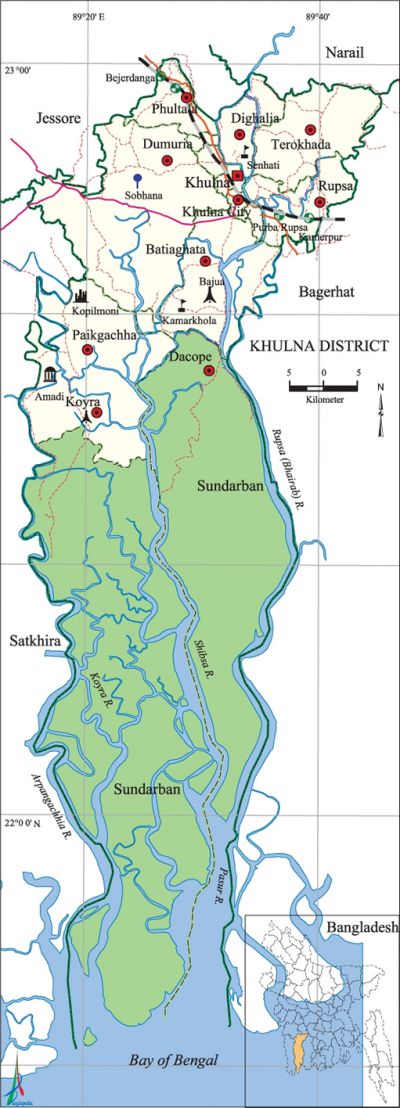Khulna District
Khulna District (khulna division) area 4395 sq km, located in between 21°41' and 23°00' north latitudes and in between 89°14' and 89°45' east longitudes. It is bounded by jessore and narail districts on the north, bay of bengal on the south, bagerhat district on the east, satkhira district on the west.
Population Total 2378971; male 1244226, female 1134745; Muslim 1821119, Hindu 540693, Buddhist 15818, Christian 289 and others 1052.
Water bodies Main rivers: rupsa (Bhairab), Arpangachhia, shibsa, pasur, Koyra.
Administration Khulna district was established in 1882. Khulna Paurasabha was declared on 12 December 1884 and it was up graded into a Municipal Corporation on 12 December 1984. Khulna City Corporation was declared on 6 August 1990
| District | |||||||||
| Area (sq km) | Upazila | Municipality | Union | Mouza | Village | Population | Density (per sq km) | Literacy rate (%) | |
| Urban | Rural | ||||||||
|
4395 |
9 |
2 |
74 |
759 |
1119 |
1284208 |
1094763 |
541 |
57.81 |
| City Corporation | |||
|
City corporation |
Metropolitan thana |
Ward |
Mahalla |
|
1 |
5 |
31 |
181 |
| Khulna Metropolitan Thana | ||||||
|
Name of Metropolitan thana and GO code |
Area |
Ward and union |
Mahalla |
Population |
Density |
Literacy rate (%) |
|
Kotwali 51 |
9.45 |
9 |
63 |
250651 |
26524 |
72.86 |
|
Khan Jahan Ali 48 |
28.95 |
2 |
4 |
108317 |
3742 |
71.30 |
|
Khalishpur 45 |
11.47 |
10 |
41 |
235018 |
20490 |
73.72 |
|
Daulatpur 21 |
11.81 |
6 |
34 |
118380 |
10024 |
66.85 |
|
Sonadanga 85 |
8.42 |
7 |
42 |
172079 |
20437 |
68.91 |
| Others Information of District | ||||||||
|
Name of Upazila |
Area |
Municipality |
Union |
Mouza |
Village |
Population |
Density |
Literacy rate (%) |
|
Koyra |
1775.41 |
- |
7 |
72 |
131 |
192534 |
108 |
44.46 |
|
Dumuria |
454.23 |
- |
14 |
203 |
237 |
279862 |
616 |
48.66 |
|
Terokhada |
189.48 |
- |
6 |
31 |
96 |
110628 |
584 |
45.06 |
|
Dacope |
991.57 |
- |
10 |
26 |
107 |
157489 |
159 |
49.34 |
|
Dighalia |
77.71 |
1 |
4 |
30 |
42 |
120782 |
1565 |
55.15 |
|
Paikgachha |
411.20 |
1 |
10 |
171 |
212 |
248112 |
603 |
45.84 |
|
Phultala |
56.83 |
- |
4 |
18 |
29 |
76941 |
1654 |
57.97 |
|
Batiaghata |
248.32 |
- |
7 |
132 |
169 |
140574 |
566 |
52.97 |
|
Rupsa |
120.15 |
- |
5 |
64 |
78 |
167604 |
1395 |
54.68 |
Source Bangladesh Population Census 2001, Bangladesh Bureau of Statistics.

Historical events About 600 years ago Pir (saint) Khan Jahan Ali came to this district to preach Islam. He, for the first time, established settlements in the Sundarnbans area and established his control over the region having his seat in Bagerhat. Mahatma Gandhi visited Khalishpur of the district to invigorate Swadeshi Movement.
Marks of the War of Liberation Mass killing site 3; memorial monument 5, memorial sculpture 1 (Bir Bangali).
Literacy rate and educational institutions Average literacy 57.81%; male 63.26%, female 51.83% Educational institutions: university 6, medical college 1, homeopathic college 1, college 27, art college 1, polytechnic institute 6, secondary school 50. Noted educational institutions: khulna university of engineering and technology (1969), university of khulna (1991), Khulna Medical College (1992), Khulna Homeopathic Medical College, Darul Ihsan University (1989), Asian University of Bangladesh (1996), Azam Khan Commerce College, Brajalal College, Government Pioneer Mahila College, Government Sundarban Adarsha College (1969), Kopotakkho College (1984), Zobeda Khanam Mahila Degree College (1996), Hazi Mohammad Mohsin College, Khulna City Corporation Collegiate School, Khulna Zila School (1885), St. Joseph's High School, Coronation Government Secondary School, Tutpara Model Government Primary School (1896), Koyra Madinabad High School, Sundarban Secondary School, Victoria Infant Primary School, Khulna Alia Madrasa.
Newspapers and periodicals Daily: Tribiun, Janmobhumi, Purbanchal, Probaho, Anirban, Janabarta, Tatthya, Rajpather Dabi, Satya Khabar, Hizbullah, Pathaker Kagoz, Juger Sathi, Kalantor, Viswabarta and Mail (present); Periodicals: Purushottomadyuti, Shikar and literary periodical Padatik (present); Weekly: Khulna, Janoveri, Padoddhoni, Rupsa, Chhayapath, Ganobani; Periodicals: Agami, Ityadi and Deshkal (defunct).
Main sources of income Agriculture 34.90%, non-agricultural labourer 6.22%, industry 3.51%, commerce 19.60%, transport and communication 5.17%, service 18.27%, construction 1.99%, religious service 0.21%, rent and remittance 0.78% and others 9.35%.
Folk culture Folk songs including Jari, Sari, Kirtan, Gazir Gan, Halui Gan, Manasha Bhasan, Bhati Pujargan etc are notable. Folk games and sports still prevalent in the district include Kabadi or Ha-du-du,Gollachhut, horse race, Kanamachhi, Lathikhela (playing with sticks), wrestling, Danguti, Boat race, Baghbandhi, Jor Bijor, etc. Dramas are also performed by various theatre groupsS.
Important installations or tourist spots the sundarbans, Khulna Shipyard, Khulna Stadium, Khulna Circuit House, Khulna District Court, Khulna Hadis Park, Central Jail, Khan Jahan Ali Bridge (Rupsa Bridge), Khulna Hardboard Mill, Khulna Paper Mill, Khalishpur Wonderland Shishu Park, Jahanabad Cantonment Zoo, etc. [Sandipak Mallik]
See also The upazilas under this district.
References Bangladesh Population Census 2001, Bangladesh Bureau of Statistics; Cultural survey report of Khulna District 2007; Cultural survey report of upazilas of Khulna District 2007.
